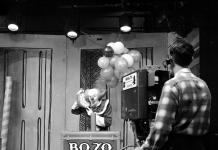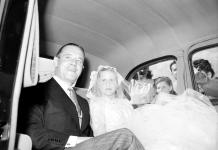
1913 In an undated photo, a stationmaster checks the ticket of a passenger ready to board a train at one of the 10 track gates at — located in Detroit’s Corktown neighborhood — which served as the city’s principal railway depot from 1913 to 1988. Owned and operated by the Michigan Central Railroad, a subsidiary of the New York Central Railroad, the station offered routes running throughout the state and as far north as Mackinaw City, in addition to routes to cities in other states, including Chicago and Cleveland. A tunnel underneath the Detroit River provided convenient train travel to New York and Canadian cities.
For generations, the massive building saw travelers from many walks of life, ranging from immigrants and Southerners seeking auto jobs to soldiers in two World Wars; presidents from Theodore Roosevelt to Harry Truman; and other notable visitors, including Thomas Edison, Charlie Chaplin, and Babe Ruth. When the Detroit Tigers arrived at the station after winning the 1945 World Series, an estimated crowd of 8,000 exuberant fans stormed the station to greet their heroes.
Designed by the firms that created New York’s Grand Central Station and built in the Beaux-Arts style, the $2.5 million structure featured an 18-story office tower and an ornate three-story depot highlighted by a jaw-dropping grand concourse with high vaulted ceilings, marble floors, and bronze chandeliers.
Up to the late 1940s, the station hosted more than 4,000 travelers every day. By the next decade, train travel had declined due to increased air travel and the construction of a national highway system. Within a few years, the station’s shops and restaurant closed. In 1971, Amtrak took over the nation’s rail service, and it operated the station until 1988 when the last train departed for Chicago on Jan. 5.
Ownership changed hands several times as the structure was neglected, stripped of many of its fixtures, and graffitied while becoming a symbol of Detroit’s decline and a popular subject of “ruin porn” photography. Due to its 1975 listing on the and the lack of funds for demolition, the iconic structure was spared the wrecking ball.
In 2018, Ford Motor Co. purchased the structure from the Moroun family for a reported $90 million, then spent upwards of $740 million to renovate the building and four other adjacent sites as part of a mixed-use campus focused on advanced automotive technology.
Ford opened Michigan Central’s doors on June 6 in special ceremonies celebrating one of the nation’s most visible redevelopments of a historic building. Meanwhile, there is speculation that in the future, rail service could resume at or near the facility.
This story originally appeared in the June 2024 issue of Â鶹·¬şĹ Detroit magazine. To read more, pick up a copy of Â鶹·¬şĹ Detroit at a local retail outlet. Our digital edition will be available on June 6.
|
| Ěý |
|








